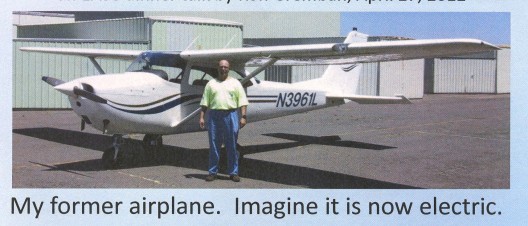Ron Gremban is an early developer of plug-in electric hybrid (PHEV) automobiles, having helped convert hundreds of Toyota Priuses to extend their electric-only range and make them even more practical real-world automobiles.
His 2008 writing on the differences between the Prius and Chevrolet’s Volt shows an ability to consider the actual physics and engineering involved rather than allowing the heat of the debate to obscure the realities. Backing from Dr. Andrew Frank of UC Davis gives further credibility to Gremban’s views.
Given his demonstrated abilities and his dispassionate vision, it’s no surprise that Gremban would look at projected electric flight in ways that haven’t yet occurred to its most ardent promoters. On April 27, at the Friday evening Motors theme dinner, as part of the Electric Aircraft Symposium hosted by the CAFE Foundation, he shared some of his concerns about potential safety concerns for electrified flight.
For instance, how do pilots and know that an electrically-powered propeller is “on” or activated when it is not moving? We know that traditional aviation practice is to yell “clear!” and to assure ourselves that bystanders have gone a safe distance away before firing up the engine. The noise and visual indications let people know the engine is active after that – although even that’s not enough to prevent several unfortunate prop strikes each year.
The electric airplane’s propeller could be there, lurking, as it were, a potentially destructive element. One clever possibility, according to Gremban, is to start the motor in a one rpm mode, with the propeller turning as an indicator the motor is on.
The state of charge (SOC) for a battery concerns Gremban. As electric aircraft go higher and fly through cooler air, their batteries become “less capable,” in his phrase. As cells reach a low SOC in cold temperature, how do we measure their true state? Is there enough energy left to allow a go-around? How low can the SOC go before causing damage or shortening the battery’s lifetime? How do we determine true charge reserve to allow staying within 30 or 45-minute standards?
He suggests other problems that need common solutions, such as pushing the power system past 100-percent output in emergencies such as clearing a tree. How will pilots know that systems are working as they should and not giving bad readings because of a low battery?
Even though individuals and manufacturers have reached means of addressing these issues, Gremban thinks it would be helpful if standards and protocols could be in place for these and other concerns surrounding this new technology.
He would like to see a non-binding industry consortium come together, much like his non-profit CalCars program which developed the first plug-in hybrids.
Ron can be reached at Gremban@forsites.com, www.linkedin.com/in/RonGremban, or at 415-758-7014. If you have serious ideas that would help fellow electrical aviators, Ron wants to hear from you.

